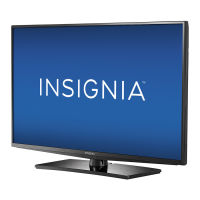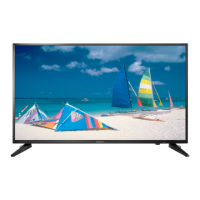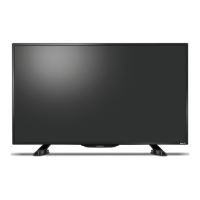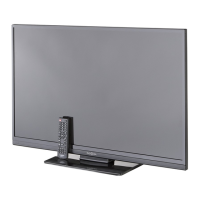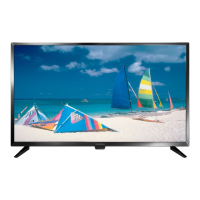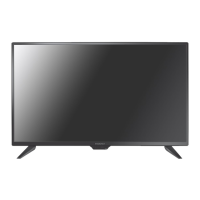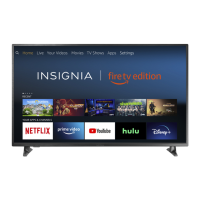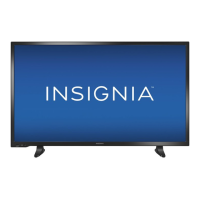
Do you have a question about the Insignia NS-39D310NA17 and is the answer not in the manual?
| Screen Size | 39 inches |
|---|---|
| Display Type | LED |
| Refresh Rate | 60Hz |
| HDMI Ports | 3 |
| USB Ports | 1 |
| Smart TV | No |
| Built-in Wi-Fi | No |
| Energy Star Certified | Yes |
| Audio Output | 10W |
Safety guidelines for using the television, including cord routing and preventing tip-overs.
Instructions and recommendations for safely mounting the TV on a wall or ceiling.
Guidelines for safely moving and placing older CRT televisions.
Warning about removing covers and exposing the device to moisture.
Protection measures during lightning storms and when unattended.
Safety precautions regarding external antenna systems near power lines.
Advice on handling the glass screen and precautions if the panel breaks.
Instructions for grounding outdoor antennas to protect against voltage surges and static.
Guidance on preventing TV performance issues due to condensation.
Warning about keeping mobile phones away from the TV to prevent interference.
Information on environmentally sound disposal and recycling of the TV.
Welcome message and overview of the Insignia LED TV's quality and design.
Explanation of HDMI CEC technology for device communication and plug-and-play.
Description of DTS Sound for clear audio and deep bass.
How to activate Game mode for optimized video game picture settings.
Features for audio descriptions of menus and program narration.
Step-by-step instructions for attaching the TV stands to the bottom of the TV.
Crucial safety warning about using all four VESA mounting holes.
List of items included in the TV box.
Identification and description of the TV's front panel controls and indicators.
Description of the audio and HDMI ports located on the side of the TV.
Identification and description of the audio, video, and antenna ports on the back of the TV.
Overview of the remote control and its model numbers.
Instructions for inserting AAA batteries into the remote control.
Guidance on pointing the remote control towards the TV's sensor.
Visual guide to connection types and their corresponding cable connectors.
Important warnings regarding checking jacks, secure connections, and unplugging equipment.
Instructions for connecting a cable/satellite box using HDMI for optimal quality.
Instructions for connecting a cable/satellite box using AV cables for standard quality.
Instructions for connecting a cable/satellite box using coaxial cable for basic quality.
Steps for connecting an antenna or cable TV directly to the TV using coaxial cable.
Steps for connecting a DVD or Blu-ray player via HDMI for optimal quality.
Steps for connecting a DVD or Blu-ray player via AV cables for standard quality.
Steps for connecting a game console via HDMI for optimal gaming performance.
Steps for connecting a game console via AV cables for standard performance.
Steps for connecting a computer to the TV via HDMI for display.
Instructions for plugging a USB flash drive into the TV's USB port.
Warning about safely removing USB drives to prevent data loss or damage.
Steps for connecting headphones to the TV's audio output jack.
Warning about loud noise and headphone volume settings.
Instructions for connecting audio systems using a digital optical audio cable.
Instructions for connecting audio systems using analog audio cables.
Diagram illustrating connections for a home theater system with various devices.
Instructions for connecting the TV's power cord to a power outlet.
Warnings about power source, unplugging for extended periods, and permanent cords.
Step-by-step guide for inserting AAA batteries into the remote.
Instructions on how to properly aim the remote at the TV's sensor.
Safety advice regarding battery handling, heat exposure, and disposal.
Guide to programming universal remotes with Insignia TV codes.
How to find and view universal remote control codes in the TV's menu.
Guide to the initial Easy Setup wizard for language, time, and source.
Options to watch TV immediately or customize settings.
Steps for setting time zones and creating custom input labels.
Finalizing TV setup by selecting the video source and completing the wizard.
Final steps for setup depending on connection type (cable, antenna, or box).
Instructions for powering the TV on, off, and entering standby mode.
How to switch between different connected devices and video inputs.
Overview of the main menu categories and their contents.
Overview of the Picture menu options for image adjustments.
Overview of the Audio menu options for sound adjustments.
Overview of the Channels menu for channel management.
Overview of the Settings menu for system configurations.
Overview of the Accessibility menu for assistive features.
Accessing help information and system details.
Overview of the Photos menu for viewing USB content.
Instructions on using the remote control buttons to navigate menus.
Methods for tuning to channels using number buttons or channel up/down.
How to control TV volume using VOL+/- and MUTE buttons.
Using the INFO button to display program and channel details.
Explanation of INlink for controlling HDMI CEC devices with the TV remote.
Steps to enable or disable the INlink feature in the TV settings.
Configuring automatic power off for connected HDMI CEC devices.
Configuring automatic TV power on when a connected device is turned on.
Enabling TV remote control for audio receiver volume.
Viewing connected HDMI CEC devices recognized by the TV.
Choosing a specific INlink-compatible device for control.
Instructions for plugging a USB flash drive into the TV's USB port.
Warning about safely removing USB drives to prevent data loss or damage.
Navigating and viewing photo files stored on a USB drive.
Instructions for starting and controlling a photo slideshow from USB.
Guide to adjusting picture modes like Vivid, Standard, Movie, Game, and Custom.
Explanation of different picture modes and their effects.
Adjusting how the picture fills the screen (Normal, Zoom, Wide, Cinema, Auto).
Detailed explanation of settings like Overscan, Brightness, Contrast, Color, and Sharpness.
Enabling automatic aspect ratio adjustment based on TV program.
Configuring the picture mode that displays when the TV is turned on.
Guide to improving sound quality with mode, balance, bass, and treble adjustments.
Selecting where TV audio plays (Auto, On, Off).
Choosing between Headphones/Audio Out Variable and Audio Out Fixed.
Turning off the TV picture to listen to audio only.
How to scan for and store available TV channels.
Steps to hide channels from the channel list.
Creating a custom list of preferred channels for quick access.
Accessing and viewing the list of favorite channels.
Assigning or modifying custom labels for channels.
How to check signal strength to troubleshoot picture degradation.
Introduction to parental controls for restricting content viewing.
Steps to set or change the password for parental controls.
Configuring the TV to block programs without ratings.
Defining U.S. and Canadian rating levels for content restrictions.
How to download program rating information for parental controls.
Disabling physical buttons on the TV for security.
How to enable, disable, or turn on closed captioning when muted.
Choosing analog captioning modes (CC1-CC4, Text1-Text4).
Choosing digital captioning modes (CS1-CS6).
Adjusting digital caption style, size, font, color, and opacity.
Steps for manually or automatically setting the date and time.
Configuring the TV to automatically turn off after a set period.
Changing the on-screen menu language to English, French, or Spanish.
Enabling or disabling automatic detection of connected video devices.
Customizing input source names for easier identification.
Overview of accessibility features like Voice Guide, Closed Caption, and Video Description.
Enabling audible narration of menu selections and remote functions.
Guidelines for TV care, including temperature and cleaning instructions.
Introduction to common TV problems and their solutions.
How to access TV system details for troubleshooting purposes.
Accessing information on remote codes and connecting soundbars.
Instructions for updating the TV's firmware via USB for performance improvements.
Running the Easy Setup wizard again to adjust settings.
Performing a test to ensure the TV speakers are functioning correctly.
How to reset all TV settings to factory defaults.
Solutions for problems like no color, snow, or inconsistent picture quality.
Solutions for problems like no sound, poor color with good sound, or audio noise.
Solutions for when the remote control does not work or is difficult to program.
Troubleshooting no power, 'no signal' errors, and missing channels.
Solutions for inaccessible settings, password loss, and grayed-out options.
Solutions for cabinet creaks, input issues, auto turn-off, and retail banners.
Troubleshooting issues with connected INlink CEC devices.
Resolving problems with device control, power, volume bars, and root menu access.
Detailed technical specifications for the 39-inch Insignia TV model.
Detailed technical specifications for the 50-inch Insignia TV models.
Physical dimensions and weight of the TV with and without the stand.
Specifications related to the LCD panel, resolution, refresh rate, and aspect ratio.
List of available input ports on the TV.
Compliance information regarding FCC rules for digital devices.
Compliance information for Canada regarding television receiving apparatus.
Information regarding Dolby audio technologies and trademarks.
Details of the one-year limited warranty for Insignia TVs in the US and Canada.
Details of the one-year limited warranty for Insignia TVs in Mexico.
Instructions on how to get warranty service for the product.
Information on what is covered and not covered by the warranty.
Information on where to obtain warranty service and product data.
Contact information for product questions and accessibility support.
